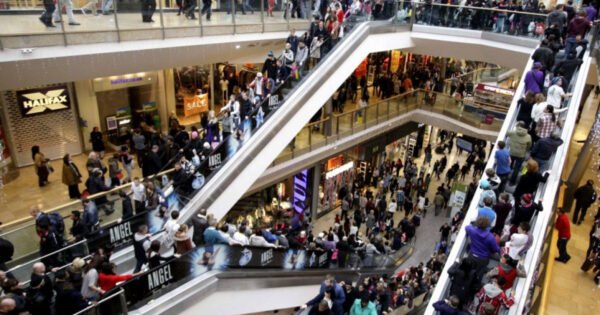India has a ‘ghost mall’ problem resulting in a loss of over $524 million, Knight Frank’s report show

An increase in ghost malls has become a strange problem that India is currently facing.
An increase in ghost malls has become a strange problem that India is currently facing. As the COVID crisis declines, India has started to witness footfall rebounds. Malls have become empty structures with no shops, resulting in no crowds.
According to the most recent Knight Frank report, an international property consultant, a lot of ghost malls have emerged in the organized retail sector in India in the past few years, resulting in a loss of over $524 million.
Knight Frank’s report titled “Think India, Think Retail 2022-Reinventing Indian Shopping Malls” stated that as many as 57 malls, or 21% across the top-8 cities in the country, are currently in different stages of falling into partial ruin.
The report stated that the 57 ghost malls, in gross leasable space, comprise nearly 8.4 million sq ft.

As per Knight Frank’s report, a mall is considered to be a ghost mall when its vacancy is more than 40%.
Also, as per Knight Frank’s report, a mall is considered to be a ghost mall when its vacancy is more than 40%.
Ghost malls are the outcome of a lack of due diligence, flawed layouts with dark lanes, mall flaws like size and ownership patterns, a failure in managing consumer walk-flow, a lack of anchor businesses, and poor occupancy.
The report stated that attempts to enliven the malls and attract a good retailer mix and footfalls proved unsuccessful. Therefore, the revenue generation potential is far below the expected threshold.
Notices have been issued in these malls to shut down large-format stores that comprised an entire mall.
Also, the demolition of shops inside the mall premises, the discontinuation of operations, and the auctioning of the mall property due to non-payment of dues to the local mall authority are also underway.
However, the report also made a few suggestions for the utilization of these ghost malls.
Shishir Baijal, during the unveiling of the report, suggested vacant spaces in ghost malls be used for thrift stores, exhibitions, food and clothing banks, event spaces, and the like. Adding to that, Baijal also suggested the opening of elementary and secondary schools, as well as daycares, eldercare, and pet care.
Workforce training centers and human development centers for government services can also spring up in ghost malls, he said.
Another suggestion put forward in the report was leasing out empty spaces for long-term commercial use to local businesses that could not afford high rents in prime office business parks or popular business districts. Other solutions to reduce losses included selling the site and demolishing the existing structure.
According to the report, the National Capital Region has the largest space occupied by ghost malls, at around 3.35 million square feet, 1.38 million square feet in Bengaluru., Hyderabad by 1.14 million sq. ft, and Mumbai by 1.13 million sq. ft.
Besides, other Indian cities where ghost malls are located are Ahmedabad, which has 0.37 million sq ft, Pune, which has 0.37 million sq ft, Kolkata, at 0.32 million sq ft, and Chennai, at 0.33 million sq ft.

The report highlighted that a mall in Mumbai that was built in 2006 has now been remodeled into a full-scale retail destination as the property dealt with poor financial economics.
It is worth mentioning that, on the contrary, the report called attention to a Mumbai mall that was built in 2006 and has now been remodeled into a full-scale retail destination as the property dealt with poor financial economics.
The Atria Mall in Mumbai was initially positioned as a high-end retail property. The owners then made changes to the mall format and layout and converted it into a full-scale retail stop. A new movie theatre opening and the entrance of a French sports goods retailer helped the mall repurpose itself as a retail destination once again. The mall has attracted food and beverage, accessories, and apparel retailers, amongst others.
Knight Frank, however, remains optimistic about the recovery in retail consumption. It says that the retail industry has survived through a series of lockdowns and disruptions due to the COVID-19 pandemic and has still managed to be back on track with consumption levels across regions having reached or nearing reaching pre-pandemic levels.
According to the report, all categories, except accessories, had already surpassed pre-COVID-19 level sales in March 2022. Also, over the past four years, electronics outperformed in sales growth even during the COVID-19 hit periods, primarily driven by the work-from-home trend and consumers opting for premium products. The categories of food and beverage (F&B), department stores, and apparel also show healthy recovery after the third wave of the virus as consumers return to the traditional way of shopping.
The growth in consumption across regions and categories as normalcy returns comes as a sigh of relief for shops and will eventually help them fulfill their contractual commitments to the mall operators.
According to the report’s additional findings, the rapid growth of revenue in shopping malls is largely projected due to increasing mall supply in the next six years coupled with the sustenance of rising consumer demand. This growth in consumption is expected to be sustained by changing demographic profiles, the entry of new brands into the market, and evolving consumer tastes and preferences. The Indian mall industry’s long-term prospects are still favorable for the upcoming few years.
edited and proofread by nikita sharma




